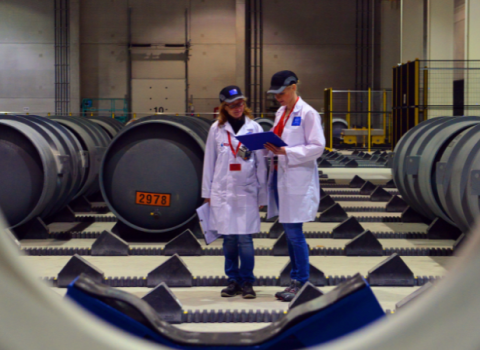
The ITER device. Image courtesy www.iter.org
The seven parties to ITER – the European Union, Russia, Japan, China, India, South Korea and the US, represent half of the world’s population. The aim is to reproduce the physical reaction – fusion – that generates energy in the sun and other stars. The use of fusion could offer a long-term solution for the world's supply of energy as it is environmentally clean and a practically inexhaustible source of power.
How fusion works
In fusion, atomic nuclei are fused together to release energy, as opposed to fission, the technique used for nuclear power and atomic bombs, where nuclei are split. In a fusion reactor, particles are rammed together to form a charged gas called a plasma, contained inside a doughnut-shaped chamber called a tokamak by powerful magnetic coils. If ITER works, a prototype commercial reactor will be built, and if that works, fusion technology will be rolled out across the world.
A fusion reactor is inherently safe, because of the small amount of
tritium available in the reactor (about 1 gram). In order for the
reaction to take place, the colliding nuclei must have energies of at
least about 10 keV, which corresponds to a temperature of 100 million
degrees. At this temperature, matter appears as plasma, where the atoms
have broken up into free charged particles.
In order for the fusion reaction to produce net output power, the
plasma must be confined so that the fusion power exceeds the power lost
by the plasma to the surroundings. This is the difficulty addressed by
experimental and theoretical fusion research.
Fusion has several attractions as a large-scale energy source; its
basic feedstocks are abundant and available everywhere; there are no
greenhouse gas emissions; no need to transport or handle radio-active
materials; no possibility of “meltdown” or “runaway reactions”; and no
long-lasting highly radioactive waste.
Complex process
This week’s initialing of the agreement brings an end to a complex and prolonged negotiation. The project began life in 1985 as a showpiece of Cold War diplomacy between the US and the Soviet Union. Formal negotiations began in June 2002 and took three years to complete, with a running dispute over whether ITER would be sited in France or Japan. Tokyo received support from the US and South Korea, with the EU supported by Russia and China. India joined the project in December 2005.
EU eventually won out. Japan was given 20 per cent of staff posts, including the director general's job, in exchange for dropping its proposal to build the reactor in its northern Aomori prefecture.
After this week’s agreement, each party will confirm the adoption of the agreement according to their national laws. The construction is then expected to start in 2007.
The seven partners will contribute the following elements to the project:
China: magnet conductor, correction coils, feeders and supports, blankets, remote handling transfer casks, gas injection system, electrical switchgear, some diagnostics.
India: vessel ferromagnetic inserts, cryostat, cryolines and cryodistribution, heat rejection system, ion cyclotron and startup electron cyclotron heating power supplies, diagnostic neutral beam, some diagnostics.
Japan: half the toroidal field (TF coils), most of the TF coil structure, part of the TF and all the centre solenoid (CS) conductors, part of the first wall, divertor outer target, blanket remote handling equipment, atmosphere detritiation, equatorial electron cyclotron launchers and power supplies, neutral beam components, some diagnostics.
Korea: some conductor strand, part of the vessel and vessel ports, blankets, assembly tooling, thermal shield, tritium storage, part of the power supplies, some diagnostics.
Russian Federation: Poloidal field (PF) coils 1 and 6 and some PF and TF coil conductor, some vacuum vessel ports, blankets and connectors, divertor dome and testing, electrical switchgear, some klystron tubes, some plasma diagnostics.
USA: wind CS coils, some TF conductor, some blankets, port limiters, part of the cooling system, part of the vacuum pumping and fuelling system, tokamak exhaust processing, part of the steady power supplies, RF transmission lines, some plasma diagnostics.
Jointly funded items: magnet feeder sensors, diagnostic first wall, assembly operations and tooling, hot cell maintenance equipment, on-site assembly of the tritium, vacuum, heating, cooling and cryoplant systems, control and data acquisition, some plasma diagnostics.
Europe: the remainder, including sharing in most of the above procurements, plus the buildings.





 A unique international forum for public research organisations and companies to connect their external engagement with strategic interests around their R&D system.
A unique international forum for public research organisations and companies to connect their external engagement with strategic interests around their R&D system.